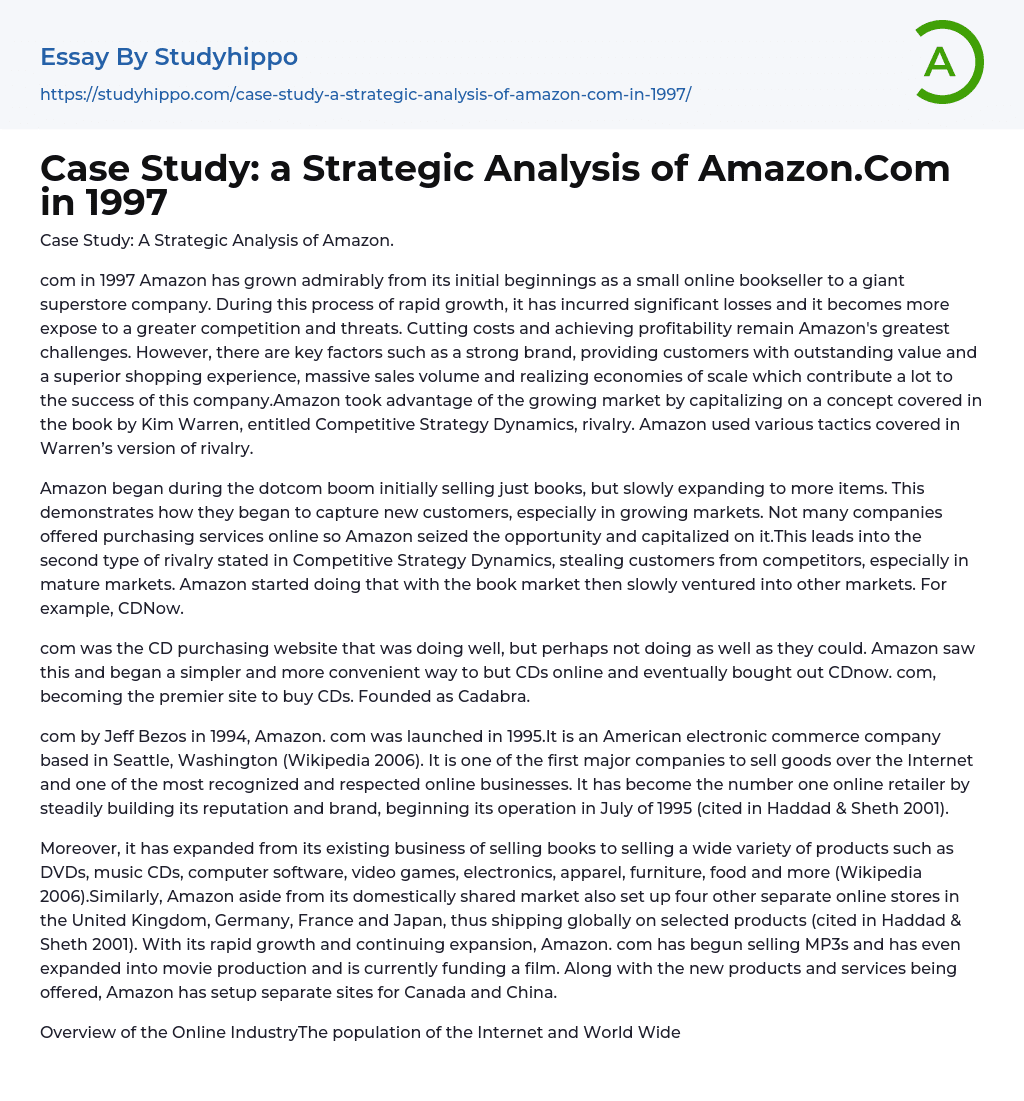

Case Study: a Strategic Analysis of Amazon.Com in 1997 Essay Example
This article presents a strategic analysis of Amazon through a case study.
Since its establishment as a small online bookseller in 1997, Amazon has transformed into a successful superstore corporation, though it has experienced losses and faces stiff competition during its period of rapid growth. Amazon's primary focus is to minimize expenses and bring in profits, while still maintaining a strong brand, offering customers excellent value and a superior shopping experience, producing massive sales volume, and realizing economies of scale, which all contribute to the firm's success. Amazon adopted the competitive strategy of rivalry described in Kim Warren's book, Competitive Strategy Dynamics, utilizing various tactics outlined in the text.
During the dotcom boom, Amazon commenced their operations by solely selling books and later diversifying their product portfolio. This aided in attracting more customers, particularly in developing ma
...rkets. Amazon recognized the opening in the market for online purchasing services and capitalized on the opportunity, which is an illustration of the first rivalry discussed in Competitive Strategy Dynamics. Subsequently, Amazon moved onto the second rivalry, which is acquiring customers from competitors in established markets. Initially, they captured the book market and then gradually expanded into other sectors, including CDNow.
CD purchasing website CDnow.com was successful, but not as much as it could have been. Amazon noticed this and introduced a more user-friendly approach to buying CDs online. Eventually, Amazon acquired CDnow.com and emerged as the top website for buying CDs. The site was originally called Cadabra.
Jeff Bezos founded Amazon.com in 1994 and launched it a year later. The American e-commerce company is headquartered in Seattle, Washington (Wikipedia 2006) and is renowned as a pioneering online retailer with a stron
reputation for reliability and trustworthiness. Haddad ; Sheth (2001) note that since its inception, Amazon.com has been consistently building its brand and has become the leading online retailer.
According to Wikipedia (2006), Amazon's range of products has expanded beyond books to include DVDs, music CDs, video games, electronics, furniture, apparel, food and more. The company has also established separate online stores in the United Kingdom, Germany, France and Japan with global shipping available for select products (cited in Haddad & Sheth 2001). In addition to this growth and expansion, Amazon has entered new industries such as MP3s and movie production. Currently funding a film project and establishing dedicated websites for Canada and China demonstrates its continuous evolution.
Since the 1990s, improvements in computer technologies have driven rapid growth in the Internet and World Wide Web populations. Consequently, many businesses have launched online, resulting in a diverse range of product sales. The pace of online purchasing has accelerated significantly, presenting great potential for success among internet-based enterprises. Nonetheless, this also intensifies competition and threats from other companies that have joined the digital marketplace (University of Texas at Dallas).
Amazon has become a corporate partner and is now responsible for hosting and powering multiple websites such as Borders, Waldenbooks, Virgin Megastores, CDNOW, and HMV. (Om n. d.)
According to Wikipedia in 2008, Amazon.com runs the e-commerce sites of several companies including Target, Mothercare, Lacoste, the NBA, Sears Canada, Sears UK, Benefit Cosmetics, Bebe Stores, Timex Corporation, Marks & Spencer, and Bombay Company. The book retail industry is thriving with significant barriers to entry and minimal supplier power over booksellers.
According to the American Booksellers Association in 2002, the internet
has caused significant changes in the book industry, including increased competition, stronger bargaining power for buyers, and more substitutes. The United States represents the largest book market. In the past, book publishing was fragmented, and a high percentage of sales were made through wholesalers. However, the rise of superstores such as Barnes & Noble and Borders.com has led to a decrease in this percentage, as they now receive direct supply of over 95% of their books from publishers.
By eliminating intermediaries like wholesalers, superstores can offer products at lower prices, leading to a growth rate of 71% compared to non-superstores' 4% sales growth. They claim a monthly growth rate of 25-35%, leading to the closure of many independent stores. This poses a threat to the success of Amazon.com, as reported by the American Booksellers Association in 2002.
Remaining competitive in the market requires relevance and convenience.
- Email essays
- Hypertext Transfer Protocol essays
- Marshall Mcluhan essays
- Virtual Learning Environment essays
- Web Search essays
- Etiquette essays
- Mainstream essays
- Vodafone essays
- Web Search Engine essays
- Adidas essays
- Amazon essays
- Apple essays
- Bmw essays
- British Airways essays
- Burger King essays
- Coca-Cola essays
- Company essays
- Costco essays
- Dell essays
- Ebay essays
- Enron essays
- Facebook essays
- Ford Motor Company essays
- Gap essays
- General Motors essays
- Google essays
- Honda essays
- Ibm essays
- Ikea essays
- Intel essays
- Iphone essays
- Johnson and Johnson essays
- Kellogg essays
- Key essays
- Kfc essays
- Mcdonald's essays
- Microsoft essays
- Myspace essays
- Nestle essays
- Netflix essays
- Nike essays
- Nokia essays
- Pepsi essays
- Pepsico essays
- Red Bull essays
- Ryanair essays
- Samsung essays
- Sony essays
- Southwest Airlines essays
- Starbucks essays



